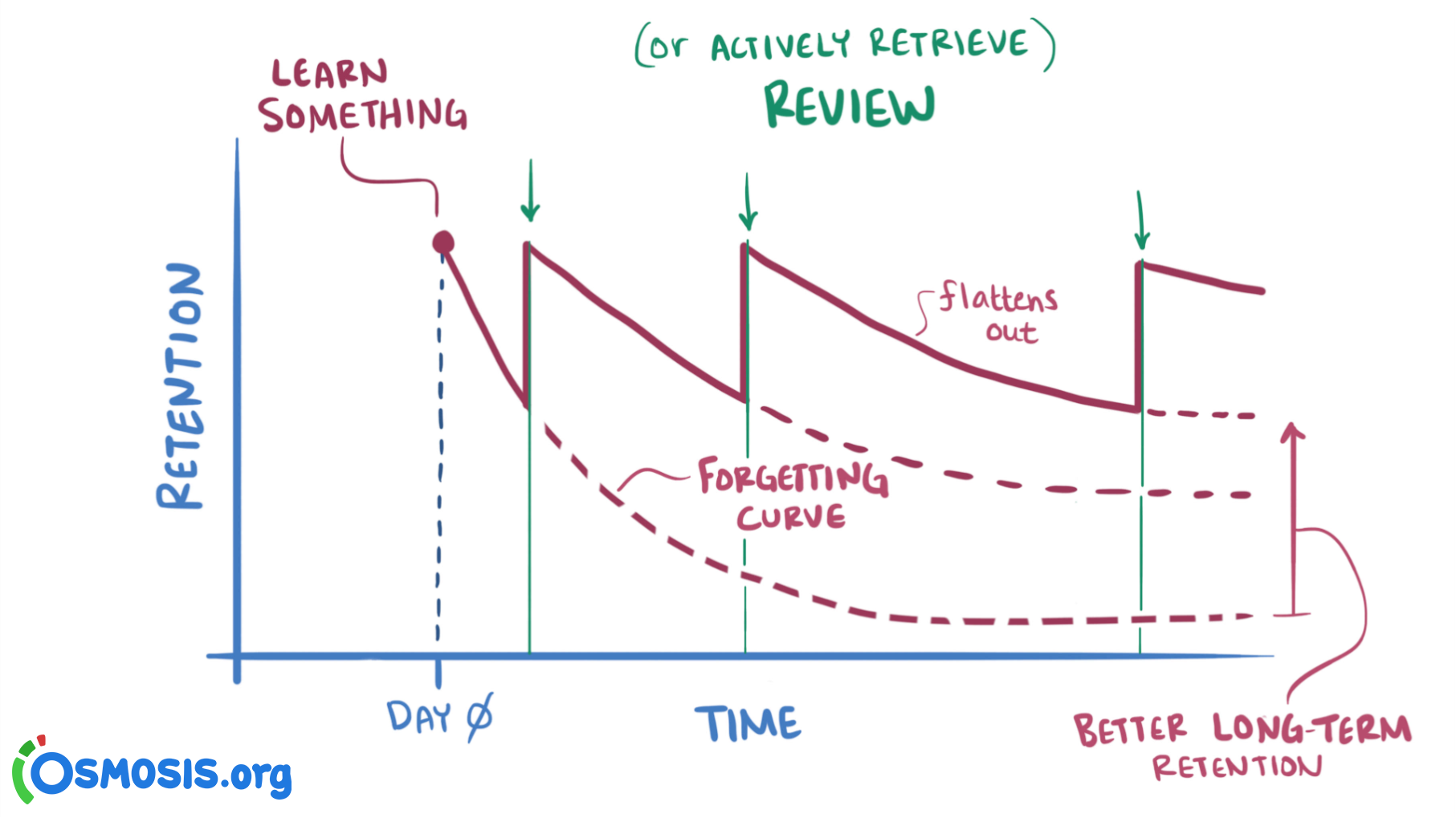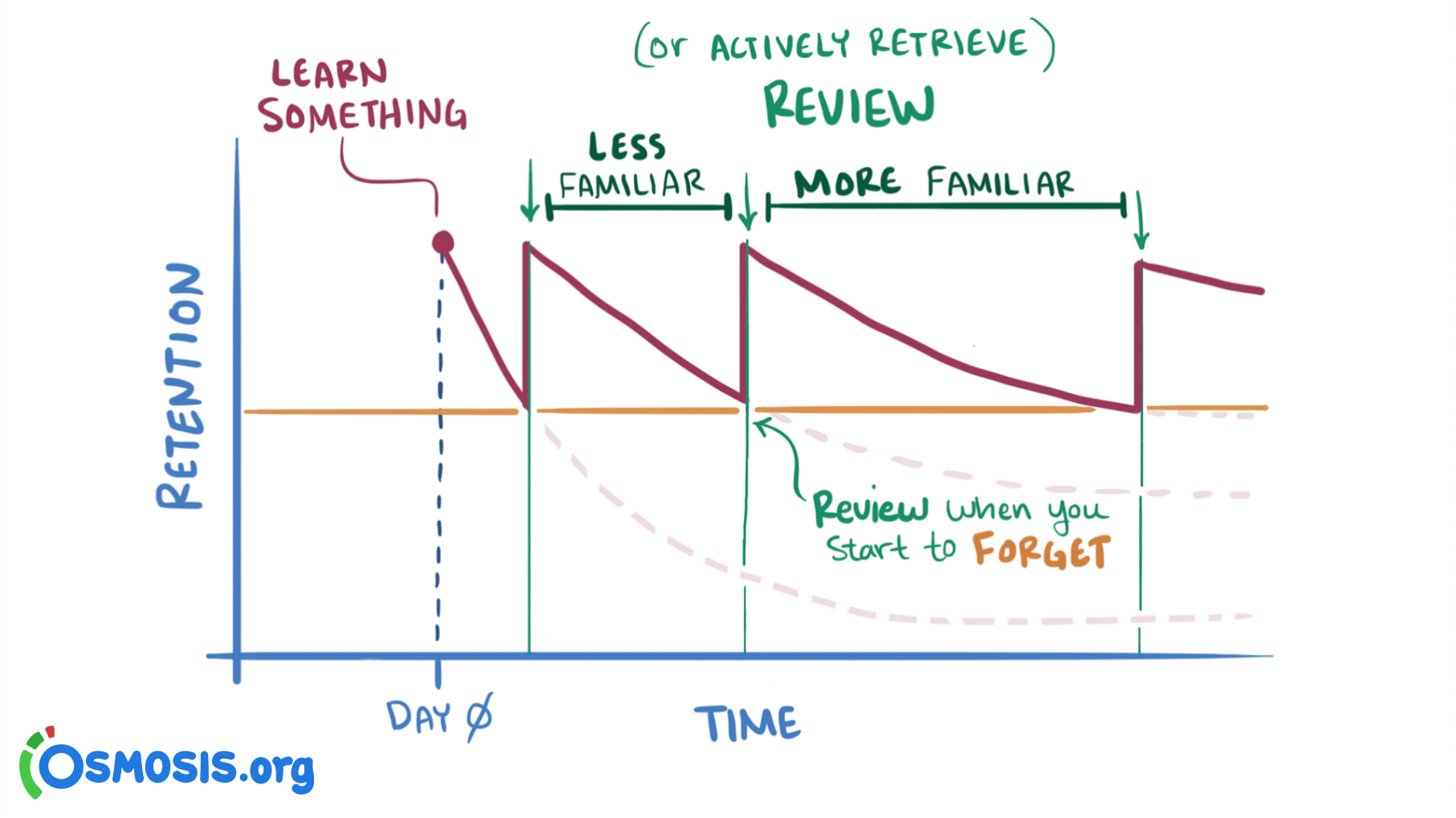Last Updated on June 26, 2022 by Laura Turner
One of the biggest challenges of learning medicine is the sheer amount of information students are expected to process and understand. By the time most students take the USMLE Step 1 exam, they will have attempted to memorize the contents of huge books like First Aid—an 800-page behemoth of high-yield pathology—as well as endless information from their course slides and other lecture notes.
(Don’t miss parts 2 and 3 in the series to learn about test-enhanced learning and memory palaces.)
To deal with this firehose of facts and improve retention and recall, it’s essential to develop an effective study plan that incorporates memory aids and other proven learning techniques. But where’s the best place to begin?
In this three-part blog series, we’re sharing three proven learning strategies Osmosis uses to make learning medicine easier for students. The first of these is spaced repetition, which we discuss in chapter 3 of our new textbook, How to Learn in the Health Professions, as well as in our video series on the science of learning.
What is spaced repetition?
Spaced repetition is about timing your information review strategically to cement knowledge into your long-term memory. This isn’t a new concept: German psychologist Hermann Ebbinghaus first described spaced repetition (also known as the spacing effect) back in ‘85—that is, 1885! To understand how it actually works, let’s first look at something called the forgetting curve.
The forgetting curve
When you hear a piece of information for the first time, it’s stored in your short-term memory. The forgetting curve is a hypothetical graph that maps out the decay of this stored information—how much of it is lost over time.

Generally, without reinforcement, studied information will decay exponentially. The goal of spaced repetition is to review the information you want to learn at critical moments so you can flatten out the forgetting curve and make it part of your long-term memory.
Spaced repetition is pretty much essential for learning medicine effectively. One study showed that medical students who didn’t use spaced repetition as part of their learning strategy forgot up to 33 percent of their basic science knowledge after just one year, and by two years, that number had increased up to 50 percent.
On the other hand, students who did use spaced repetition significantly outperformed their peers—some studies have shown learning efficiency can improve by up to 40 percent using the technique.
So, what’s the best way to make sure you’re spacing out your study sessions appropriately?
It’s all about timing
It turns out that the optimal time to refresh your knowledge is to review information right as you’re about to forget it. Obviously it’s difficult to do this precisely without the help of an algorithm, but a good rule of thumb is to space out the studying of new information in short intervals and to gradually lengthen those intervals as the information becomes more familiar.

It’s also not enough to simply re-read information every few days. To best take advantage of the power of spaced repetition, students should aim to mix up their learning activities. One way to do this is to spend a day studying information and then to self-test a few days later using practice questions or flashcards.
How spaced repetition helps with learning and time management
Using spaced repetition optimally requires tracking the forgetting curve for each individual piece of information you’re learning—an impossible task for even the most powerful human brain. Luckily for learners, we now have sophisticated computer algorithms that track this automatically. So how do these work?
Let’s say you’re studying for a test with online flashcards that use a spaced repetition algorithm, (like the ones you’d use on Osmosis). If you give a wrong answer, the spaced repetition algorithm takes note of that and will test you on that piece of information again fairly soon.
Similarly, spaced repetition algorithms will be less likely to test you with questions you’ve answered correctly in the past (but they’ll still come up from time to time to reinforce that knowledge).
Spaced repetition algorithms also help with studying efficiency by ensuring that you’re focused on the material you’re having the most difficulty retaining.
Using spaced repetition can be challenging (and even frustrating at times!), particularly when you’re being tested right at the point when you’re about to forget something. Ultimately, you should see this as a good thing. Remember, studying is exercise for your brain: if you’re not breaking a sweat, you could probably push yourself a little harder!
To learn more about spaced repetition and other optimal study strategies for medical and health education, visit osmosis.org.

